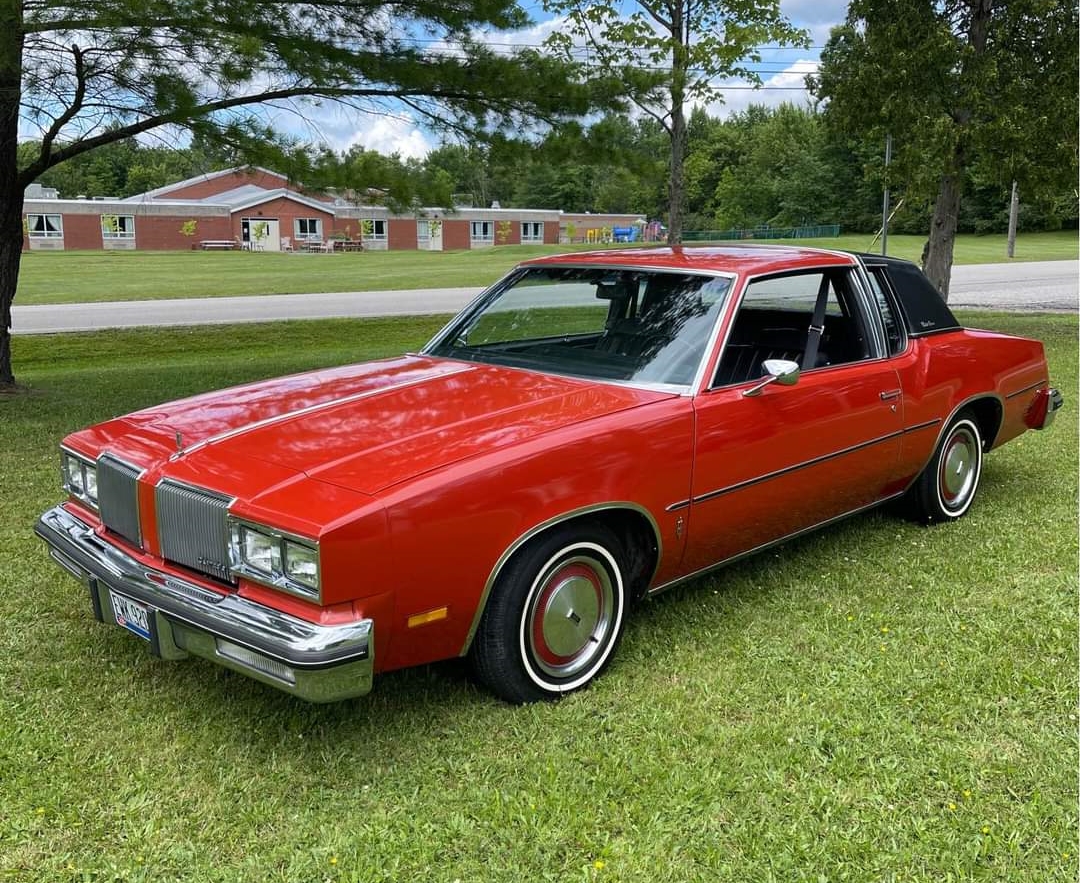
Hey guys, here’s another one you’ll love! Or love to hate. So instead of skimming the article and reading something more to your taste, get ready to properly stretch, grit your teeth and happily complain and fight about bad old GM. Dagnabit! Consarn it! And dadgumit! Oops. Sorry. For a minute I thought I was on some second-rate site that’s been going downhill for several years. Silly me! Well, y’all know where that is ifin you’re so inclined…
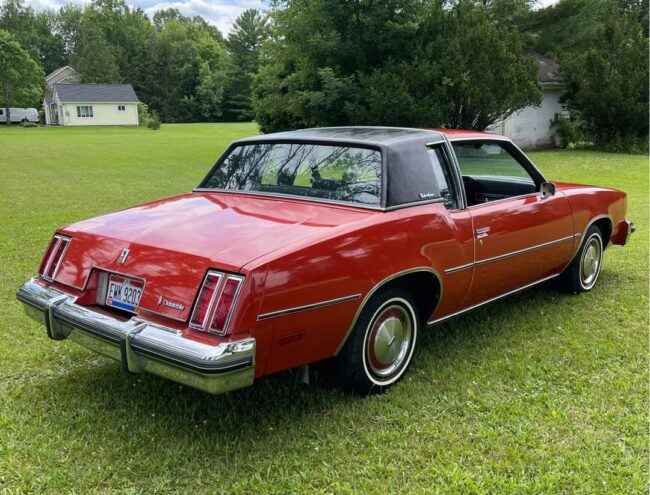
I kid, I kid. Well, sort of. But never mind! Here’s another one spied on my friends, Chuck Houston and Joe Tralongo’s, site, Finding Future Classic Cars, on that ‘bookface’ website. A time capsule ’80 Cutlass Supreme.
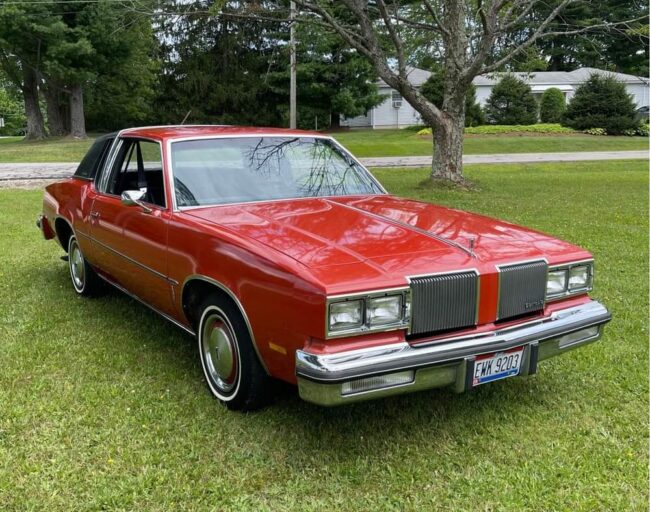
At the time of writing it was on Marketplace in Chesterland, Ohio, for the sum of $7500. It appears to be Cinnebar, a bright nonmetallic red that was available on many GM cars in ’80. With a black landau top and matching black vinyl bench seat interior. I dig the color keyed wheel covers too. I have an ’80 Monza dealer promo in that color. They also made an ’80 Monte Carlo promo in that color. I haven’t gotten one for the collection yet, but my friend Jim Smith still has a couple. Fortunately.

As the ad explains: “This is a barn find 1980 Oldsmobile Cutlass Supreme. Two door, automatic transmission, 260 V8 engine, excellent condition without question. Numbers matching, all original. Runs and drives!”
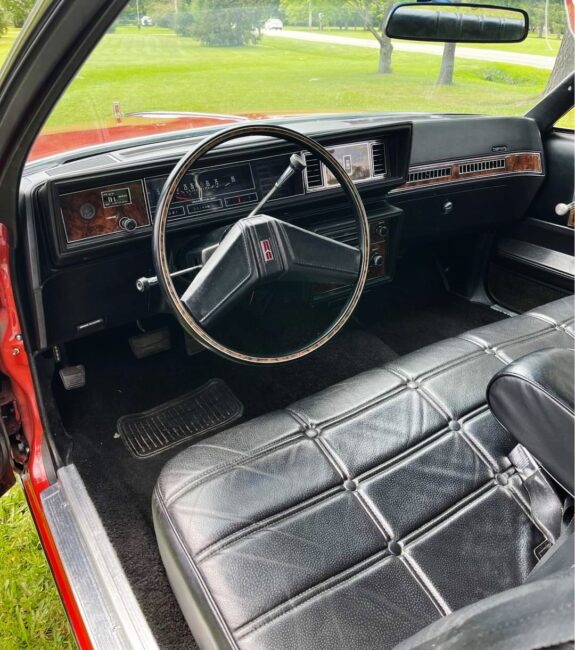
“You can see the original spare tire and jack still in the trunk. And all the original manuals / paperwork still in the glovebox. This car has been in my family since it was purchased new back in the day. My grandfather only drove this car on the weekends and it has never seen any snow nor hardly ever any rain it’s entire life.”
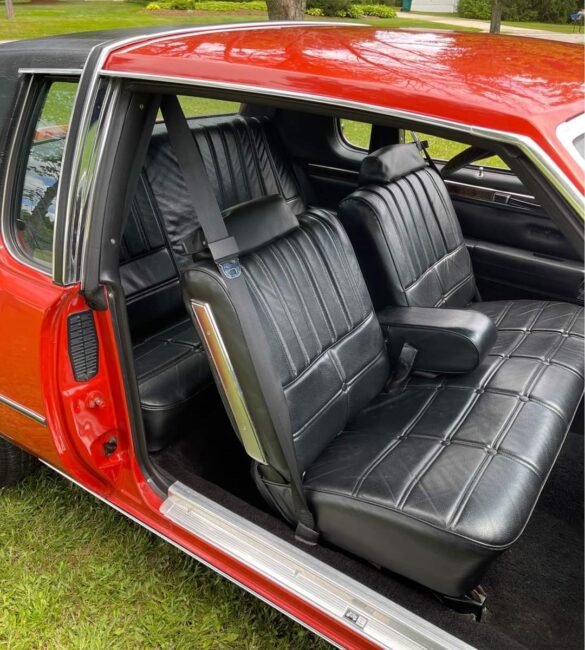
“We just recently put a new battery in it and got it out of storage to clean up and sell. We have a clean Ohio title as well, ready to go. The vehicle is located at my dad’s property. Serious buyers can message me with any questions and I can give contact info for my dad for you two to set up a time to see the car in person.”

Just one drawback, assuming you’re into these newly downsized 78-80 A-body personal-lux coupes, which succeeded the 73-77 Colonnade Cutlass, Monte Carlo, Regal and Grand Prix. It does not have air conditioning. I think it might be the only 1978-80 Cutlass Supreme I’ve ever seen without it! So keep that in mind. And with no A/C and the Dark Black interior, hope you like it hot. Well, some like it hot. But I prefer conditioned air myself. Unless I’m up at the lake out on the deck in my patio chair, a novel and several gin and tonics. But I digress.
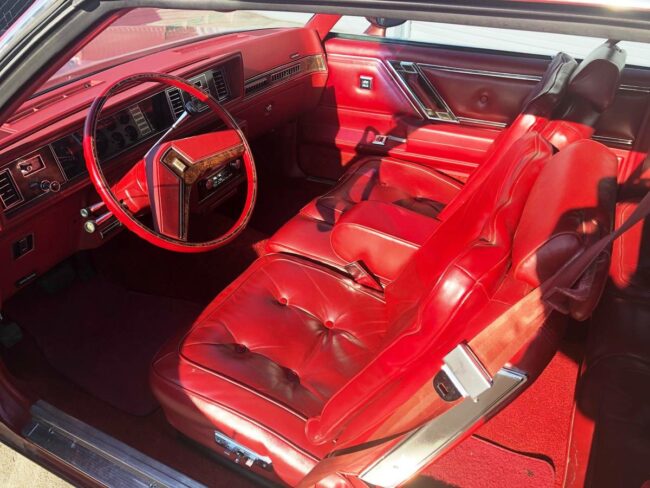
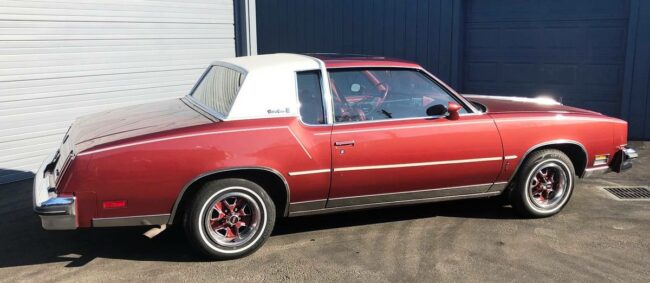
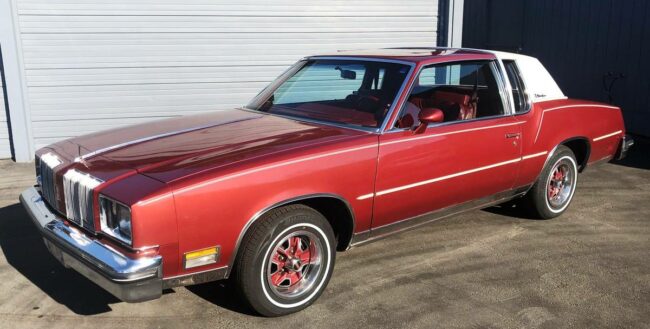
This one is equipped more to my preferences. A loaded ’79. THIS is the one I’d want. Colors. Wheels, trim. With the oh so comfy button tufted leather interior. And cornering lamps! You’ve gotta have cornering lamps. It was also on Steve and Joe’s group a while back, in California, but has since sold-to a fellow member, where it is now living the good life.
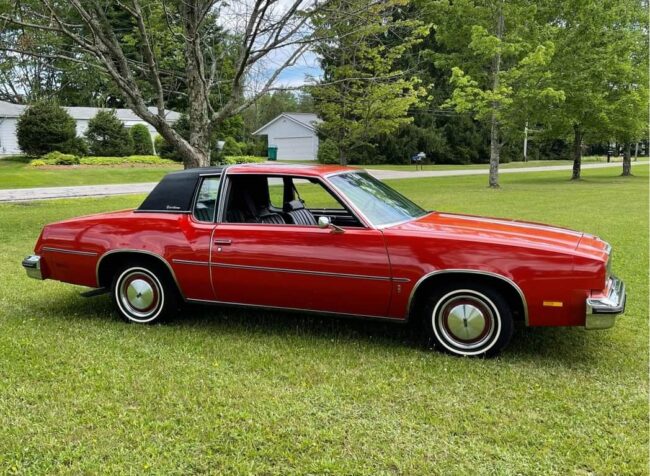
So until next time ladies and germs, keep on battlin’ against bad old GM! Go back in time and slap Roger Smith. Kiss your Kia. And don’t forget to tip your bartender. Now where’s my margarita? Dagnabit!








31 Comments
Ronnie was talking on the other Sunbird thread how he liked the first downsize but loathed the fwd 80s round of downsizing. It seemed a common view, to say the least.
While a few of these 78-80 intermediates had some interesting combinations from a typical long domestic options list, I am not quite so enamored. CAFE was not yet a reality and inflation was high, yet here was GM giving you less for your higher price. The Cutlass had less style and less size. Worse there were now sixes and not even a smooth relaxed inline but a 90 degree unbalanced V6. I remember the local dealer on tv in 1977 saying buy a Cutlass now, next year they will be smaller. Ronnie tied the Citation to malaise, but to me, these were the malaise. A little like what you get a restaurant these days soon after reopening, higher prices, less service, and most important worse food.
The front drives on the other hand, with a massive investment only GM could still make, was GM going back on the offensive. Understanding that CAFE was the imposed on them reality, they reimagined what they built in a way to give the customers what they were used to in room, power but in a new package with off the charts efficiency. The subversives never expected that, and that is why it was what they hated the most, A small efficient maneuverable car like they always said they wanted, just not from Detroit.
Having already stomached and met CAFE, GM went to the government and asked for imports to be limited to the record numbers they were already dealing with. This was very important. With the large investment in new models and the bad economy, GM needed to fill their large production capacity to employ their workers and pay dividends to their shareholders. Both groups then all American remember.
Instead the government allowed the Japanese non union American assembly points with unlimited capacity. The result? Well what was Toyota doing in 1981, directly copying the x body with the first, American assembled Camry.
Honda was a little more out in the woods. Imagine 1981 at Honda. They had finally retired the last 2sp auto in America and their biggest engine was newly enlarged all the way up to 107 cubic inches. A new assembly point coming and high fives all around or whatever Japanese do. Then Mr. Honda stands, puts up a picture of the then new Pontiac 6000 and says that is what we will be building by 1990. A nervous engineer asks, “What will we call it sir? An Accord of course, the little stuff was just a foot in the door, we want the whole market. the biggest in the world. Sir uh, I think our buyers like the small stuff. Mark my words son, the useful idiots will go along, it is all arraigned.
Hope you enjoyed this Tom, It took me a while to write
I enjoyed it, and I think you raise a really interesting point – the transverse-mounted FWD platform.
Was the GM X-platform the first “Major” car with that setup?
My father was a big GM fan, and ordered his early enough to get one of the first cars off the assembly line. He ordered manual with the V6; so we didn’t have to deal with the (iffy?) automatic transmission, or the iron duke 4. It was also remarkably well put together, and we did not have any of the build quality issues that other owners have identified.
I bought it from him 8 years later with about 70,000 miles. It had a new clutch by that time. Over the next couple of years, I had to change the radiator & thermostat, heater core, and tie rods. Not sure how that compares to other cars of similar vintage.
Handling was “weird”, but I was a sixteen-year-old idiot who drove way too fast. Significant understeer, followed by a snap spin. I am lucky that the car didn’t kill me.
What made it unique was the availability of the V6 that offered better acceleration than the 305 V8 in the Nova, an interesting counterpoint to the Chrysler k whos hemi 2.6 was hopeless compared to a Volare’318. The V6 Tempo was 9 years away as was the V6 Camry. British Leyland had the FWD wedge compacts sold under Austin, Morris, Wolseley, and Leyland Princess labels starting in 1975, but not in the USA.. The higher line ones had a 2.2 OHC transverse inline six e series engine with the transmission in the engine sump instead of end mounted. The six was dropped before the end of the run in 1980 because the the replacement 1983 Austin Montego model was deleting down to VW transmissions that couldn’t handle the six. The wedge had the same wheelbase as the Citation. Here is a picture of the Wolseley version. https://www.bing.com/images/search?q=wolseley+18-22&id=D01FEC6196A65F6EB81CC55EC0FAE4695DB49053&FORM=IQFRBA . It was designed by Harris Mann who also did the TR7.
CAFE was introduced for the 1978 model year. The Camry’s development began in 1977, in response to the first Honda Accords, just like GM’s own transverse-engined FWD compacts. There may have been a time when the Japanese were copying everything from English and German to UAW cars, but it was Detroit copying Japan by 1980.Where do you think the idea for the Ranger and S10 came from?
John C. is into those alternative histories that school children receive today instead of actual facts. In John’s world the UAW and Detroit management of the 1970s and 80s were all working together to offer the best built, most reliable, and most advanced cars in the world to provide good middle-class jobs for middle-America, but brainwashed American consumers fed lies about Japanese superiority on the pages of Consumer Reports and Car & Driver were ignoring or bad mouthing the valiant and innovative efforts of Roger Smith, Henry Ford II, and Douglas Fraser and not buying their fine cars except for the few barn finds that Tom highlights.
Of course if we want to follow John’s alternative history it does become problematic that the copycat engineers at Toyota were able to get a copy of the problem plagued GM X-body in 1979 and engineer, test, and start manufacturing their “copy” in the form of the 1st generation Camry in a world record 2 years that proved to have a bulletproof reputation for reliability, durability, and build quality, which is something no GM Detroit small car in history has been able to demonstrate. Kind of reminds me of the alternative history taught in schools where the kids learn that evil white people keep black people down and yet the teacher never explains why all those racist white kids and their parents try to be like Mike with a purchase of Air Jordans, and/or watch billionaire Oprah Winfrey every day on TV, and vote for Barack Obama for the most powerful office in the world, or why Asian-Americans earn more prestigious degrees and earn more money than whites in white privileged America. When the facts are on your side use the facts, but when they aren’t make stuff up.
Spring 1979-fall 82=3.5 years. First Camrys had faulty ignition modules and automatic transmissions . Also simpler with only one outsourced too small engine and some front drive work pre done with 80 Tercel.
Stingray is still with all the apes running wild through all the factories. Soon we will find the Statue of Liberty in ruins on the beach. Rotten, Stinkin apes!
The subversives were running wild however in ghettos of journalism. Compare period photos of auto mag staffers to big three executive’s photos their job was to cover. Then think which group Reagan would compare to Tarzan like he did hippys? The physiology difference is just as obvious as the open mawed soyboys of today
CJ, Accord wheelbase 1977 93.7. Citation wheelbase 104.9. 1983 Camry wheelbase 102.4. Accord 4 door GM reaction Euro J car Americanized with displacement and pushrods.
Accord weight 1977 2024 Citation 5 door 2507 1983 Camry 5 door 2468
Do you honestly think changing the wheelbase of a transverse-engined FWD car is leadership while building the first car to gain consumer acceptance and then adoration with the layout is not? I notice you didn’t defend your incorrect assertions about product timing and CAFE. Good for you. The ’80 Corolla Tercel had a longitudinal engine, so it didn’t contribute much to the parallel development of the Accord-modeled Camry.
You are talking about Minis and Fiat 128s as front drive pioneers, not Accords. You may also remember that engines might shift over RWD to FWD or back again, but transmissions require a full redesign to operate as transaxles. Why you saw zero RWD and no trucklets from golden age Honda. Too much work for the work shy.
I will give you credit or is it blame for your normal pose that the Euros were the way, the true, and the light, to shifting that transaxle into overdrive to shill for 70s Japan. The enemy of my enemy America is my friend, so thinks CJ and Stingray.
Minis and FIAT 128s were as important to the American market as blood sausages. The Accord was the first transverse-engined FWD car to gain acceptance as a desirable car for people who could have spent the money on a Cutlass if they didn’t care about quality, engineering or efficiency. I remember a married couple telling the story about what they went through to get their first-generation Accord at one of my partents’ dinner parties. They were on a waiting list and when their names came up they had the option of taking what came off the truck or going to the bottom of the list. Did you want the LX 5-speed with standard A/C? Too bad. You can take this automatic base car and we can put A/C in it, or you can wait another four months while your Regal guzzles gas and refuses to start on hot, cold or wet days. Nobody did that for a FIAT. The Rabbit arrived before the Accord, but the first model year cars were penalty boxes for the broke or spartan. It was the Accord that magazines characterized as being like a small car built by Mercedes-Benz.
I love it that you question my patriotism while driving a Chinese car. Did you vote for Beijing Joe too? I don’t support the UAW because the UAW supports the threat posed to my existence by the Democrat party. Management? Look at what the Ford Foundation does to our values and our security. GM is as Chinese as Nike. Stellantis? Honda sided with CARB against the American people, so they’re dead to me now. If I need more new cars, I will buy Toyotas; probably ones made in the US by people whose wages aren’t diverted to my enemies.
I didn’t say the Mini and Fiat were important to America or GM, they were important to Honda. Without them Honda wouldn’t have make it past motorcycle based bubble cars.
Enjoy the fun 90s liberal, How dare you question my patriotism just because I hate American institutions throwback. Face it CJ. There was a choice in the 1980s between the suits of American business, the subversives of the press, the arts and academia and the blood suckers of Wall Street, here represented by H Ross Perot. You went with the blood suckers. All these years later, you are smart enough to realize you zigged where you should have zagged.
My family actually had the kind of immigrant mentality that stemmed from wanting to be Americans, not just to live in America. Until 1986, every car purchased by my family was an American car. A Buick, two Chevrolets, two Chryslers, seven Dodges, a Ford, three Plymouths and a Valiant(pre-Plymouth) are the ones I remember. We only stopped buying them because the last ones were terrible. We didn’t even know how terrible they were until we started buying imported cars and learned what we’d been missing.
As superior as Chrysler products had seemed after a Buick on my mother’s side and my father’s experience with a Ford and two Chevrolets; giving up after the 1985 Dodge Lancer ES that became a bloody burden after 17,000 miles and buying West German cars was a revelation. Then reunified Germany started turning out self-recycling turds and it was even more wonderful to buy Japanese cars that just work.
If you don’t think that American business was already fully corrupted by Frankfurt-school college educations and big government in the ’80s, then you really aren’t swayed by reality. The ‘hippies’ at Car and Driver were down-sized Chrysler engineers. If American business loved the American people, why did Spanish Chrysler A-bodies have four-wheel-disc brakes while American ones had four-wheel-drums that barely worked? Why did GM and Ford consider so many technologies they used in Europe to be too expensive for Americans when we were an economic power?
There’ a difference between not supporting a market so protected that a few powerful players get away with selling garbage and supporting the Democrats’ efforts to offshore the drugs that big pharma has gotten away with making everyone dependent on. I have never purchased an inferior imported product by choice. I have purchased superior imported products and inferior domestic ones by choice. I have been a member of a union, I’ve managed union workers, and I’ve managed a project to break a union. You think unions are about giving people security so they can lead full lives. I know that unions in practice create broken people, broken industries, broken products, and corruption. Look at the police. Every day there are cops assaulting the people who want them to keep their jobs. Sort of like the UAW did to GM customers.
Careful CJ, when we bring it up to modern times we start agreeing. The only question seems to be when the institutions were last savable. I would put that at 2000, 2008 at the latest. If there is a new Morning in America, Tucker Carlson or Nick Fuentes will have to go back to first principles and build new institutions. The thinnest of slim chances.
The A bodies in Spain were tricked out because they were the prizes for those around Franco, another man who tried to right a sinking ship by going back to first principles. They just desecrated his corpse..
When was GM savable? The more important question is why did GM need to be savable? They were the largest and most profitable company in the world in the 1960s, Peter Drucker wrote a book praising their management practice as one of the best run large companies in the world when Toyota was barely surviving by rebuilding GMC 6×6 trucks for the US Army during the Korean war, and Honda was building 50cc scooters. The 1963 Corvette that Tom posted the other day hardly generated any comments because everyone agrees it was a fantastic world beating car, but 10 years later GM couldn’t deal with higher gas prices and CAFE rules because the whole US auto industry (and the high UAW wages and restrictive work rules) was built on high profit large cars and none of the Big 3 really wanted to build small cars that were anything except a means to upsell a potential import defectors into a full-sizer for “only a few dollars more per month” that they made more money on. The only reason Detroit still exists at all is because CAFE offered a break on “trucks” that allowed the Big 3 to revert to their old model of building the same big pickup or pickup based SUV several million times per year to make huge profits. In contrast, the foreigners had to learn how to make a profit on excellent small cars because their home markets had high taxes on fuel and/or large cars (mainly to keep American cars out), which meant they were in the ideal position to establish themselves during the oil crises and CAFE era of the 1970s, but they were still small companies that GM could have crushed like ants if they hadn’t switched from being engineering oriented to being run by bean counters.
I agree with most of that Stingray. It should be remembered though that the auto industry as a whole by the 1980s was only growing about 200,000 per year, less than 2 percent with wild fluctuations based on economic conditions. Even if every one of those incremental new sales went domestic, there was no need for new plants as productivity was going up faster than that. So all the new assembly points, don’t call it manufacturing, were going to empty out existing plants and make them unprofitable. All the government had to do was say no to that, it wouldn’t have cost the taxpayers a dime.
Some of you like to talk up Demming. Remember when he was pedaling his theories in Japan it was in the 1950s. He was born around 1900. I can see how his rows of meaningless figures will impress autistic Japanese more than the dramatic but to them scary teeth of Tony Robbins, Even a simple mind like mine though can look at what Japan built in the 1950s and dismiss any quality claims. To that I would add Malcolm Baldridge, the American quality movement figure. His job in the 80s was Commerce Secretary. As such, it was him that got his clock cleaned in the period talks on Japanese car import restrictions. Another quack for quality.
Truly, American car styling ‘artistry’ virtually disappeared after say, 1974-1976, which is when the ‘square’ and ‘downsized’ horrors like these Oldsmobile models began to hit the streets. The Chrysler New Yorker/Newport (and their Dodge/Plymouth siblings) along with the big Fords/Mercs/Lincolns kept the fires buring into 1978-1979, then everything went square, bland, and downright dorky, in terms of sheetmetal styling.
For a long, long time.
That said, GM did improve the aerodynamics of the 1981-1987 versions of the Cutlass, Monte Carlo, Gran Prix, and Regal (especially the Regal), and at least that was a step in the right direction, however small it might have been. My dad owned a new ’87 Regal Limited, but its 231 V-6 was unimpressive, rear seat room was crummy, and its handling was only sos-so. At least it had that cool luminescent rectangle on the passenger side dashboard facing, wow, really cool!
Dad liked the car pretty well, regardless, and Mom really loved it, go figure!
Then again, they weren’t car enthusiasts like I am.
CAFE is what forced Detroit to downsize and square up their cars, and the reason these down-sized “mid-sizers” proved to be pretty reliable is they literally were the same body on frame car with an emission choked OHV 6 or 8 as their larger predecessors, but just kept in the dryer a few cycles longer. The biggest complaint I remember is that the 4 doors did not have roll down rear windows which GM claimed was a move to maintain elbow room in the narrower bodies, but everyone knew was just a way to cut costs and encourage more people to order the high margin A/C (that the owner of this red barn find Cutlass chose not do). Of course at the time GM touted the squarer look of their shrunken cars as a high style “formal” look that mimicked top-of-the-line Cadillac Seville while providing nearly the same interior space as their much larger predecessor, and pretty much everyone copied the square look until the jelly bean Audi 5000 and Ford Taurus arrived.
I was 8 years old in the summer of 1979 when my dad took me down to Key Oldsmobile on the east side of Columbus to look at Cutlass Supremes (“the best-selling car in America!”). He asked to drive one with “the small V8,” having not bought a new car since his 1970 Camaro, when they still had small-block and big-block V8s. So they put us in a gold Brougham with the 260, and Dad gets on the freeway onramp and mats the pedal…and not much happens. Dad’s Camaro was just a 307 2bbl with 3-sp stick, but it would’ve run rings around that Cutlass.
So he asks the salesman if he has anything with more punch, and the salesman shows him the Hurst/Olds with the Rocket 350. Sadly, we didn’t even test-drive the H/O because the sticker was over $12K if I remember correctly, and Dad didn’t want to spend more than $9k. So the salesman showed us his one and only Cutlass Supreme in stock with the Chevy 305 4bbl. Not a Brougham, but it did have A/C and AM/FM stereo (the Camaro had neither) and Dad took it home for ~$8300 including tax and scam fees. Dark brown metallic with tan interior, Olds rally wheels, and no vinyl top. ELO and Styx sounded nice on the radio. Dad was happy…
..but not for long. Sadly, it was one of the Chevy 305s with the “soft camshaft,” which required replacement at just over 40k miles. The A/C gave up the ghost in 1984. When I was driving it as a teen, the right front tie rod end broke as I was turning into a gas station, which resulted in me having to convince Dad that I hadn’t done anything stupid with it, like vaulting curbs or jumping train tracks. (C’mon, Dad, how far could I have driven it like that?) And I always wondered if the factory hadn’t installed the wrong front springs because it always sat a little low at the front and when you hit a big bump, the rear stayed planted while the front floated. New front shocks helped, but not a lot. The ramp from 270 East to 71 South had a big bump in the middle which was a bit of a pucker moment in that car.
But Mom always liked the Cutlass. It certainly was a pretty car.
Uggh. The Olds 260 V8: all the weight of a big-block with the power of an anemic V6. My mom bought a new, 1978 Cutlass Salon 2-door with the 260 and not-exactly-durable THM200 automatic. She was not impressed with the power in comparison with the ‘67 Chevy Impala 307/2-bbl that she traded in. By the mid-eighties the Gutless became my first car. I can’t say that I was impressed.
I bet your first car vs. my first car (slant 6 Duster) would have been a great race. At least we were faster than the Chevettes, Pintos, and automatic Rabbits most of the other kids had.
The Olds 260 had three redeeming features:
1) It got pretty good gas mileage
2) It was a very durable engine by malaise-era standards
3) It can easily be swapped for a late 60’s/early 70’s Rocket 350
I think the Buick 231 made about the same HP and got about the same MPG. Not sure why they bothered to offer both engines.
I suppose that it’s important to keep a garage find like this ‘stock’, but can any of the older wrench turners here comment on the success of disabling/dismantling the early smog controls for improved power/drivability/mpg/reliability, at least in states where it was feasible?
I don’t claim to be a wrench turner, but I think most people would just pull the 260 and 3 speed auto out and put in a crate motor and OD automatic. The only real value of a car such as this is that it has a pristine body and interior, which tend to be the most expensive things to fix/restore if rusted and trashed, but desmogging the 260 will simply result in a car that takes 14 seconds to hit 60 instead of 16 seconds, and gets 17 mpg instead of 15 and still have awful by modern standards drivability. The smart ticket would be the purchase of a plug and play crate motor with 300+ hp and FI, which together with an OD gearbox will give you serious acceleration and mid 20s MPG on the highway.
Having only owned one navy blue car among a sea of black, white, and silver:
I love the red. I love the colors. I miss them.
Just a final thought on the ‘stylish’ 60s- early 70s cars vs. ‘square and bland’ 80s styling –
My first car was a 1966 Caprice with a 390 hp 427; yes it was a ten year-old, well-worn car, but the 427/TH400/3.31 rear still made for on heck of an acceleration rush up to triple-digit speeds, and it was actually faster (just a little) than my dead-stock 383 Magnum 1970 Roadrunner.
As great as the performance was, the body style was very speciial too, far for cyrvy and sexy that the previous ’61-’64 Impalas and such. The inerior was more like a Chrysler New Yorker than a lowly Impala, and was a very posh ride indeed.
Then there was my 1974 Sedan DeVille (platinum body, white top and red leather insides), my 1974 Newport Custom (wine red with a lovely beige fabric/vinyl interior); both of these were very attractive, and from any vantage point. I really felt as I was privileged to own and drive all of these kinds of automotive ‘art’ even as the entire world drifted toward the soulless econobox, square, boring, ‘practica’l designs of the late seventies and beyond.
Not until I acquired a mint 1994 New Yorker did I feel tha I was once again the owner of a modern example of automotive styiling genius, and it was also a very well-made and comfy ride, too.
To each his own, and if folks love the 80s kind of auto styling – and there must have been 100 million of them who bought such cars new – then more power to ’em.
“…the ‘hippys’ running wild in journalism…”
Thanks, John. Gave me a smile.
Patrick Bedard was Car&Driver’s senior editor, their constant – longer at the job even than David Davis. Worked out of college as a Chrysler engineer – until, in a typical Lynn Townsend move, he, and dozens of other engineers, were laid off.
Davis, himself, was, after retiring as a racer (having rearranged his own face in a wreck) an alumni of Campbell-Ewald, an Establishment advertising agency. Oh, and an open Reagan supporter and constant advocate for free markets. Some kinda hippie, hey?
Brock Yates was the wild card, but aging out. LJK Setright was a rabbi – I was surprised to learn that. Gordon Baxter was a crusty old Texan – he’d have been on the other side of the scuffle in Charlie Daniels’ Easy Rider. About the only “hippie” you’d have found was 30-year-old contributer P.J. O’Rourke – and obviously he had secret libertarian leanings, as he later revealed in several books.
Whether you think C/D under Davis was Gonzo trash, or whether it was a sincere desire to tell it like it is, and damn the consequences…they were iconoclasts but they were anything BUT anti-establishment.
They were anti-stasis, and they had been exposed to cars built a different way. Dynamic chasses on European models. Incredible quality on Japanese brands. The two never quite got together – Japan improved their game but never to into BMW territory, but they were far beyond the rusting, mediocre trash that the American lines were pumping out.
Interesting note of how the West German cars were superior to the present planned-obsolescence unified German/EU brands. I’d noted this – I wouldn’t own a present VW if it was given to me, free; but I never put the two together in my mind.
Want to know who won the contest, GDR versus the Federal Republic of Germany? The East did. Just as AMC management took over Chrysler from inside (and McDonnell-Douglass took over Boeing from the inside) the East slipped effortlessly into the new German government, and made it more like what they had, than the system that had so outperformed them side-by-side.
Remember C/D’s suit wearing corporate overlords, forced the move out of Manhattan to Detroit in the late 1970s to bring the staff more in tune with Detroit. Notice also that Yates becomes editor “at large” because he is too cool to go to Detroit. Notice the mag then landed in Ann Arbor, a hippy dippy university town. Do you really think there was no vacant office space in 70s Detroit? Their stomachs were the problem.
Not going to go person by person as individuals have a right to their own views but lets talk briefly about Bedard as you put him forward as most establishment. Jack recently had him in Hagerty in his old age showing off his personal nice! XKE Jag. In 1976, he did their test on the new XJS. He liked the way it drove and one can imagine the challenges to BL at the time of the long knives to get this V12 car out there. He then adds paragraph after paragraph over how crazy it is to buy a Jag and isn’t even a little dated to cruise in 1976 at 140 mph. The car lasted 20 years and had the best sales at the end as a vestige of a better time. A better time C/D and Bedard wanted over.
I have a little different take on German reunification. If you go there now there is infinite sneering at old East Germany. Here look at their tv set in the east, it looks five years older than it is, ha ha. Never mind there were maybe 10 countries in the world that could build a tv and East Germany was probably the smallest. The problem in Germany in the 90s was the end of the country protections to a single Euro market. So no problem getting cheap parts from Spain and even the design teams are suddenly international with freedom of movement within the EU. The result the cars lost their national identity. A problem we already had.
Times change. What was trash, or compromised, in its own time, often ages well. Take the Willys/Jeep Station Wagon, (the Basketweave) of 1948-65. In its time it screamed poverty and dirty coveralls. Today it’s a collector’s car. Likewise that first generation of Jeep CJs.
The car-based utes, Ranchero and El Camino, never totally caught on, and in the end of their product lives, were dissed as something owned by drunks, dropouts working at the mill, or illegal immigrants here for less than a year. Today, you can’t TOUCH a 1959 El Camino for less than $100k; and you can’t find a 1957 Ranchero.
Bedard had a fascination with Jaguar. Back in 1979 he wrote in C/D about his experience buying a used E-Type out of one of those nationwide magazines of classifieds…traveled to Ohio to get it, and then, at a rest area, couldn’t find reverse. Because, according to the owner’s handbook, which he had to dig out, you had to smack the lever like you were trying to break it, as you forced it to the left and forward.
He was comparing pre-Safety-Act cars with the soulless, crappy cars of that time, but his fascination with Jaguar, its engine, its wooden steering wheel, its spinner hubs…all leaked through. It’s not a contradiction to be negative on the Jaguar XK in its time, while recognizing its attributes and historical value, forty years later.
I had owned a Camry the last twelve months. One car I swore I’d never buy. But I’ve changed and my needs have changed; and that happens with all of us. What I wanted was reliable transportation without drama or surprise cost…just what my mother wanted at my age. The then-new model, Camry, was perfect for her, and has been all right for me, lo these thirty years later.
Ann Arbor. If you’d ever been to Detroit, you’d know why Davis & Co didn’t want to settle in there. The city is a hole. The car people live in one ginormous bubble and never see anyone besides themselves. It’s a stifling, insular environment, and it explains why the executives are all like Stepford Executives and their cars all looked the same, and still do.
I’m going by David Halberstam here, as he wrote of the Detroit industry, focusing on Ford.
Manhattan likewise is a silly place to put out a car magazine – one place where one thing you do NOT want to do, is DRIVE. They were there because they were given space by their publisher parent, Ziff-Davis (no relation to David E.) Davis wanted to be close to Detroit, but not in Detroit. Where would he go, Toledo? Traverse City? In those years, there was more to universities than pot-smoking and Antifa rallies. Most college towns, including the one I’m writing from have beautiful, tree-lined districts…education is an industry with minimal environmental cost.
East Germany. One common characteristic of someone or some group running a game on you, is to say one thing while doing another. Does not MATTER what shibboleths they pronounce – they TOOK Comrade Frau Merkel and made her a semi-permanent Chancellor of the German nation. Did you know she was big in the East Berlin Communist Party when young? Has she really even changed? Only one example.
I had loved my VW, 45 years ago, and my BMW motorcycle 15 years ago. Both companies are morphing into something I don’t recognize and don’t want anything to do with. And I can’t help but think this sudden East influence, and the people who have been hired since unification, have had a lot to do with it.
“Detroit is a hole.” So is Stuttgart, that doesn’t mean Bertel should be covering their auto industry passed out in the fetal position next to the latrine behind an Asian brothel. The readers deserve better, even if Bertel was there inside with the first Golfs..
You wonder about the level of comeuppance the old timers in Germany went through. One of the last professional stories about Ferdinand Piech I heard was having them bring over an off brand Chinese CUV for his production cost people to price it out if VW built it. Then complaining the price was too much. A pretty far cry from designing the first Quatro. I think he can be forgiven for drinking Bertel style at the end. Bet the whole country is.
Cars were better when they reflected their nations identity. True for all countries, the shitholes will just have nothing to show. All you had to do was design and build primarily for yourself and interesting and unique attributes follow. To have that all replaced by a universal Asian appliance…. well you know what I think.
“Cars were better when they reflected their nations identity.”
I grew up in the Blue Ridge Mountains. The USA is a big country. My region had almost nothing in common with Detroit. Those clumsy parade floats they built were decidedly inferior for people who had to drive on roads that were once colonial paths tracing valleys and rivers. I quickly learned to love cars that could go, stop, turn and do all of the above on uneven pavement. Perhaps American cars wouldn’t have been horrible if they hadn’t been made in the flat middle of nowhere. We’ll never know for sure.
CJ makes a valid point that the really large cars were not right for everyone. What he forgets is the bad memories going back to colonial times of selling your goods overseas to wheeler dealers and then waiting to see what you got paid and the quality and price of the goods you ordered in return from overseas. A big issue with the Founding Fathers. Imagine all the opportunities to get taken advantage of. I think that is why the story he told of his parent’s friends buying an early Accord virtually sight unseen and hearing what levels of financial sodomy they were willing to endure stuck with him for 45 years. Of course, America had offered small cars before, like the Sunbird, but they were aimed at young singles in an area of family values. Thus it should be no surprise that in areas like the blue ridge mountains affordable small family cars like the Citation and Reliant arrived they were greeted enthusiastically. Here were cars that could be bought locally in the smallest towns from dealers that had been and were going to be around and were usually willing to take a little off for a good customer, and with a service department familiar with what they are selling and parts nearby. Morning in America!
The 1978 and 1979 Cutlasses were good looking cars, that 1979 is sweet! The 1980 version, not so much. For some reason, this particular car in the lipstick red and black vinyl roof just looks odd to me. Fortunately for Oldsmobile, this was a one year wonder, the “aero” G bodies came out in 1981 and were a good update on the original cars.